W20 ACCT1240 Group Case: Tesla Financial Statement Analysis
VerifiedAdded on 2022/09/18
|15
|2617
|20
Case Study
AI Summary
This report presents a case study analyzing Tesla Corporation's financial statements from the perspective of a potential investor. It examines the application of GAAP and non-GAAP accounting rules, focusing on revenue recognition, regulatory credits, and stock-based compensation. The report identifies the primary issues arising from these accounting practices, particularly concerning IFRS. The analysis explores different reporting alternatives under GAAP and non-GAAP, evaluating their advantages and disadvantages. Ultimately, the report recommends that Tesla adhere to IFRS for financial statement development, while also suggesting the use of non-GAAP for internal purposes to gain a more accurate understanding of the financial performance. The report emphasizes the importance of transparent and accurate financial reporting for investors to make informed decisions. The study also considers the roles of users and preparers of financial statements, as well as the impact of autocratic guidance, such as IFRS, on the company's reporting practices.
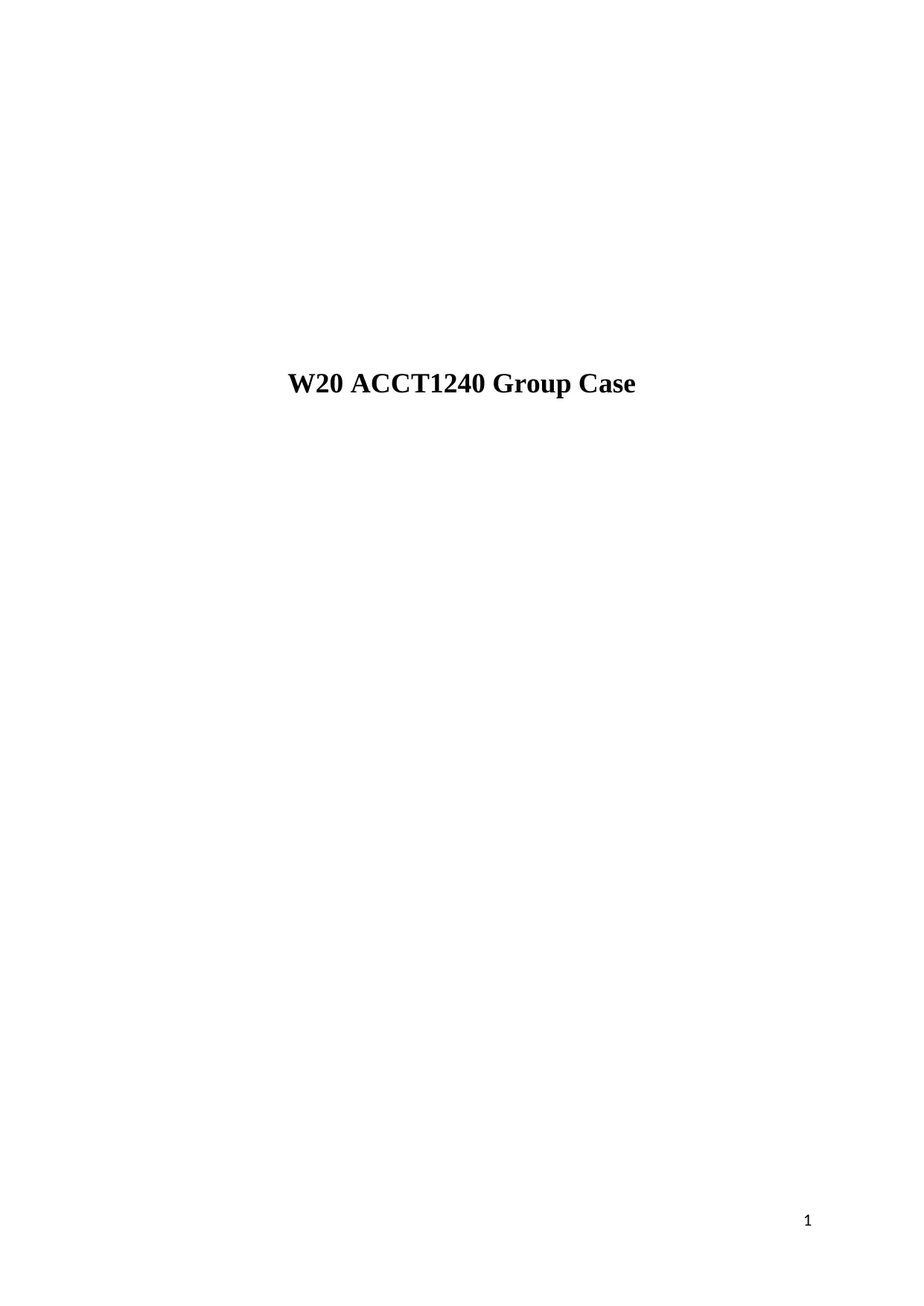
W20 ACCT1240 Group Case
1
1
Paraphrase This Document
Need a fresh take? Get an instant paraphrase of this document with our AI Paraphraser
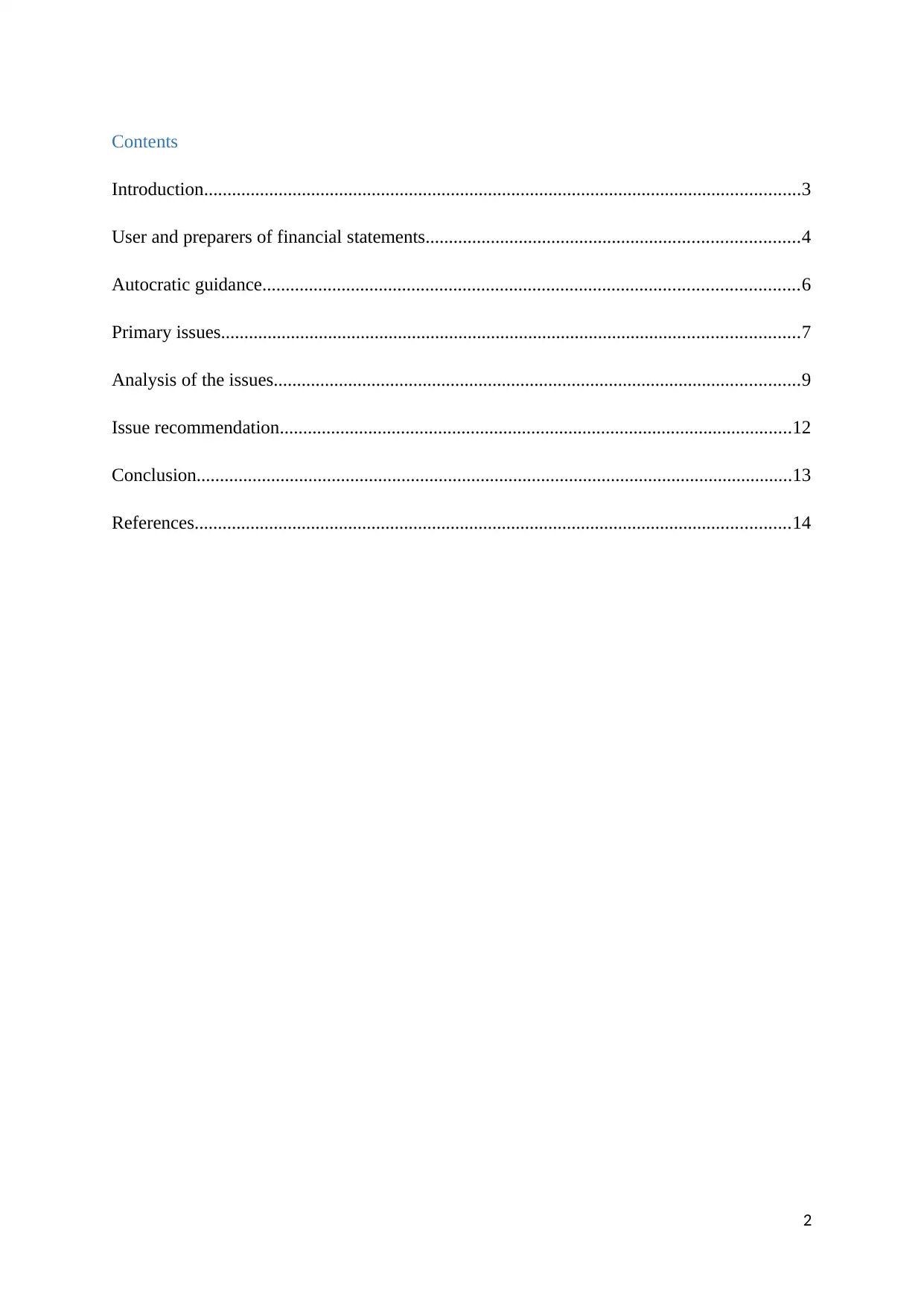
Contents
Introduction................................................................................................................................3
User and preparers of financial statements................................................................................4
Autocratic guidance...................................................................................................................6
Primary issues............................................................................................................................7
Analysis of the issues.................................................................................................................9
Issue recommendation..............................................................................................................12
Conclusion................................................................................................................................13
References................................................................................................................................14
2
Introduction................................................................................................................................3
User and preparers of financial statements................................................................................4
Autocratic guidance...................................................................................................................6
Primary issues............................................................................................................................7
Analysis of the issues.................................................................................................................9
Issue recommendation..............................................................................................................12
Conclusion................................................................................................................................13
References................................................................................................................................14
2
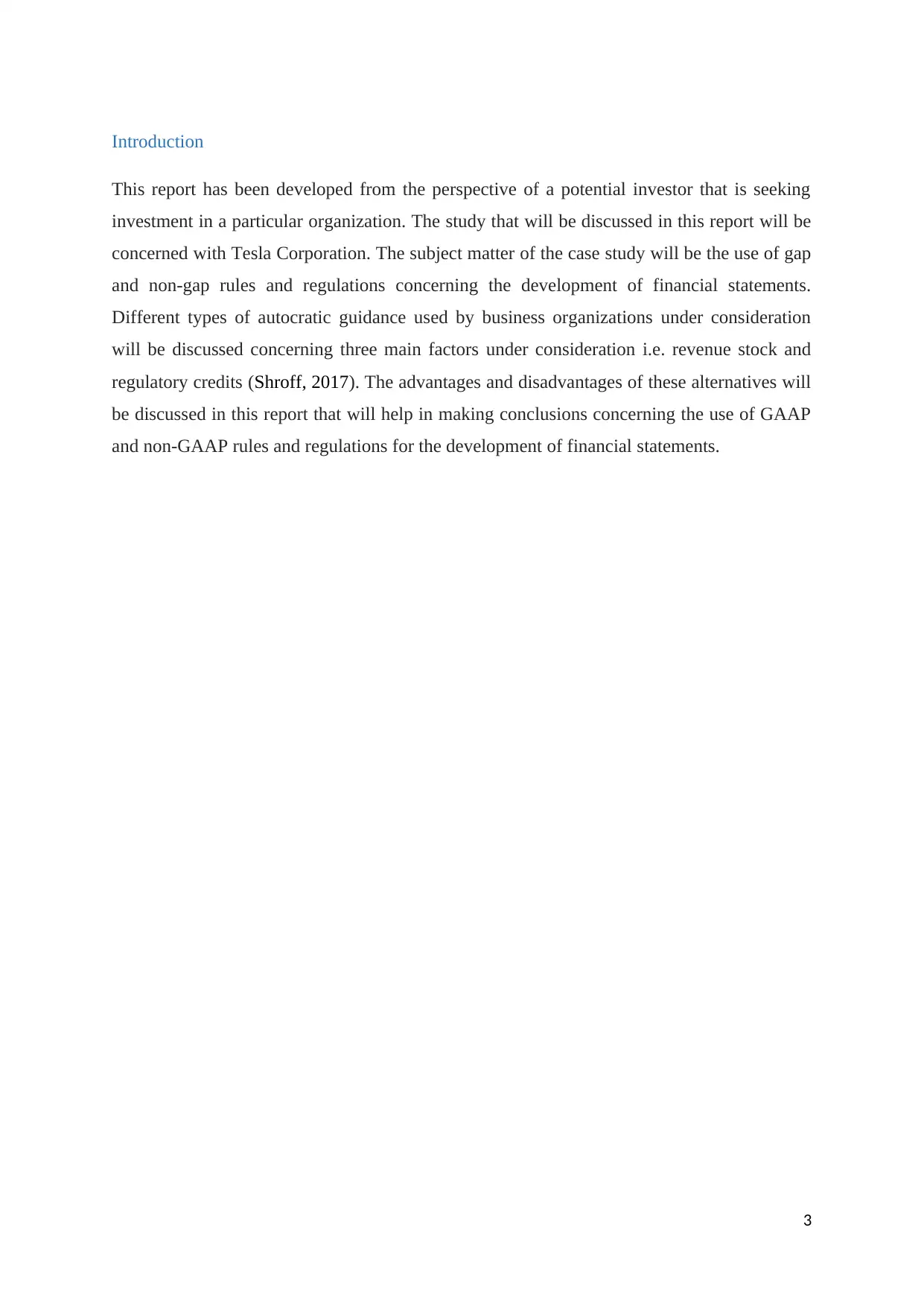
Introduction
This report has been developed from the perspective of a potential investor that is seeking
investment in a particular organization. The study that will be discussed in this report will be
concerned with Tesla Corporation. The subject matter of the case study will be the use of gap
and non-gap rules and regulations concerning the development of financial statements.
Different types of autocratic guidance used by business organizations under consideration
will be discussed concerning three main factors under consideration i.e. revenue stock and
regulatory credits (Shroff, 2017). The advantages and disadvantages of these alternatives will
be discussed in this report that will help in making conclusions concerning the use of GAAP
and non-GAAP rules and regulations for the development of financial statements.
3
This report has been developed from the perspective of a potential investor that is seeking
investment in a particular organization. The study that will be discussed in this report will be
concerned with Tesla Corporation. The subject matter of the case study will be the use of gap
and non-gap rules and regulations concerning the development of financial statements.
Different types of autocratic guidance used by business organizations under consideration
will be discussed concerning three main factors under consideration i.e. revenue stock and
regulatory credits (Shroff, 2017). The advantages and disadvantages of these alternatives will
be discussed in this report that will help in making conclusions concerning the use of GAAP
and non-GAAP rules and regulations for the development of financial statements.
3
⊘ This is a preview!⊘
Do you want full access?
Subscribe today to unlock all pages.

Trusted by 1+ million students worldwide
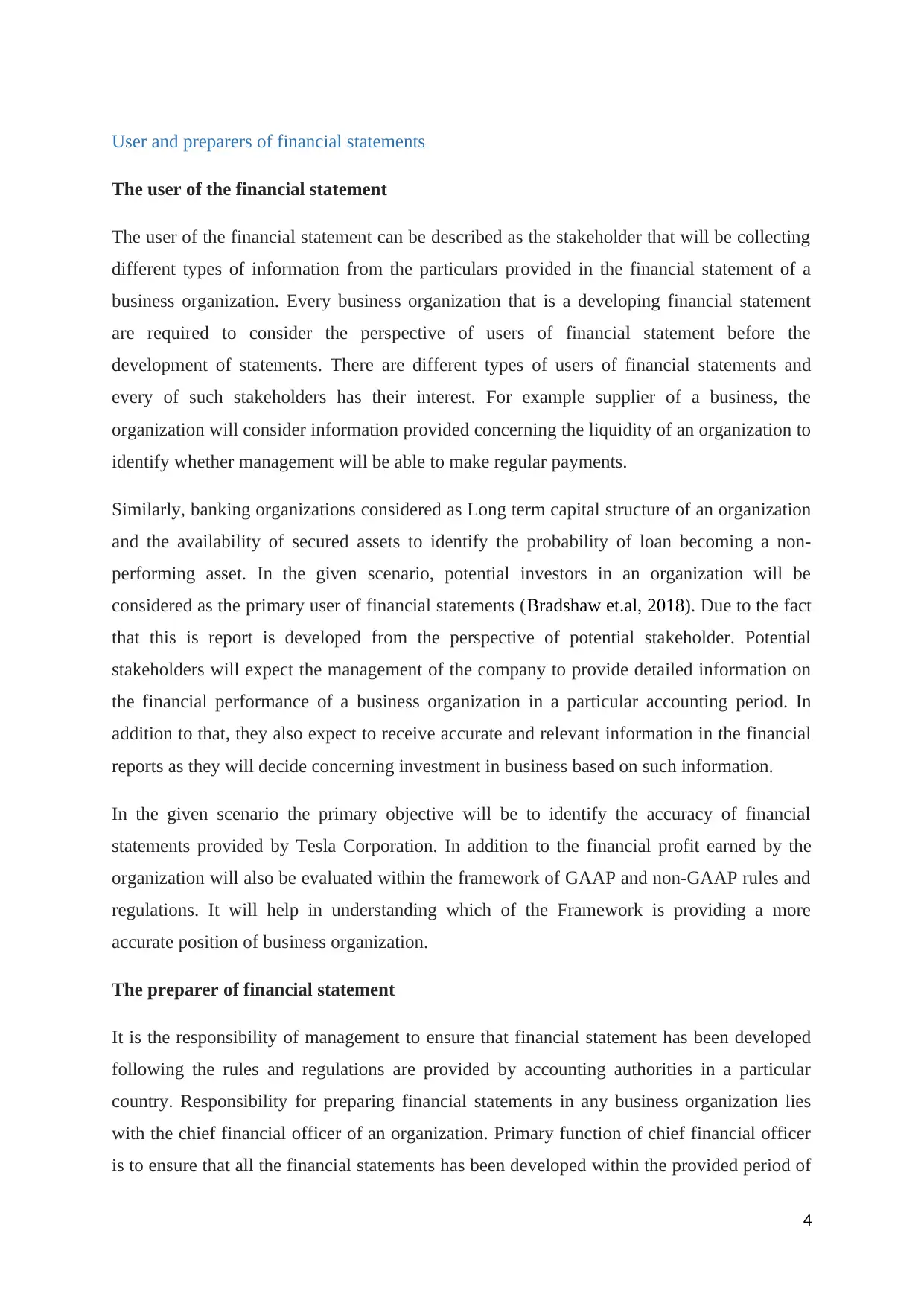
User and preparers of financial statements
The user of the financial statement
The user of the financial statement can be described as the stakeholder that will be collecting
different types of information from the particulars provided in the financial statement of a
business organization. Every business organization that is a developing financial statement
are required to consider the perspective of users of financial statement before the
development of statements. There are different types of users of financial statements and
every of such stakeholders has their interest. For example supplier of a business, the
organization will consider information provided concerning the liquidity of an organization to
identify whether management will be able to make regular payments.
Similarly, banking organizations considered as Long term capital structure of an organization
and the availability of secured assets to identify the probability of loan becoming a non-
performing asset. In the given scenario, potential investors in an organization will be
considered as the primary user of financial statements (Bradshaw et.al, 2018). Due to the fact
that this is report is developed from the perspective of potential stakeholder. Potential
stakeholders will expect the management of the company to provide detailed information on
the financial performance of a business organization in a particular accounting period. In
addition to that, they also expect to receive accurate and relevant information in the financial
reports as they will decide concerning investment in business based on such information.
In the given scenario the primary objective will be to identify the accuracy of financial
statements provided by Tesla Corporation. In addition to the financial profit earned by the
organization will also be evaluated within the framework of GAAP and non-GAAP rules and
regulations. It will help in understanding which of the Framework is providing a more
accurate position of business organization.
The preparer of financial statement
It is the responsibility of management to ensure that financial statement has been developed
following the rules and regulations are provided by accounting authorities in a particular
country. Responsibility for preparing financial statements in any business organization lies
with the chief financial officer of an organization. Primary function of chief financial officer
is to ensure that all the financial statements has been developed within the provided period of
4
The user of the financial statement
The user of the financial statement can be described as the stakeholder that will be collecting
different types of information from the particulars provided in the financial statement of a
business organization. Every business organization that is a developing financial statement
are required to consider the perspective of users of financial statement before the
development of statements. There are different types of users of financial statements and
every of such stakeholders has their interest. For example supplier of a business, the
organization will consider information provided concerning the liquidity of an organization to
identify whether management will be able to make regular payments.
Similarly, banking organizations considered as Long term capital structure of an organization
and the availability of secured assets to identify the probability of loan becoming a non-
performing asset. In the given scenario, potential investors in an organization will be
considered as the primary user of financial statements (Bradshaw et.al, 2018). Due to the fact
that this is report is developed from the perspective of potential stakeholder. Potential
stakeholders will expect the management of the company to provide detailed information on
the financial performance of a business organization in a particular accounting period. In
addition to that, they also expect to receive accurate and relevant information in the financial
reports as they will decide concerning investment in business based on such information.
In the given scenario the primary objective will be to identify the accuracy of financial
statements provided by Tesla Corporation. In addition to the financial profit earned by the
organization will also be evaluated within the framework of GAAP and non-GAAP rules and
regulations. It will help in understanding which of the Framework is providing a more
accurate position of business organization.
The preparer of financial statement
It is the responsibility of management to ensure that financial statement has been developed
following the rules and regulations are provided by accounting authorities in a particular
country. Responsibility for preparing financial statements in any business organization lies
with the chief financial officer of an organization. Primary function of chief financial officer
is to ensure that all the financial statements has been developed within the provided period of
4
Paraphrase This Document
Need a fresh take? Get an instant paraphrase of this document with our AI Paraphraser
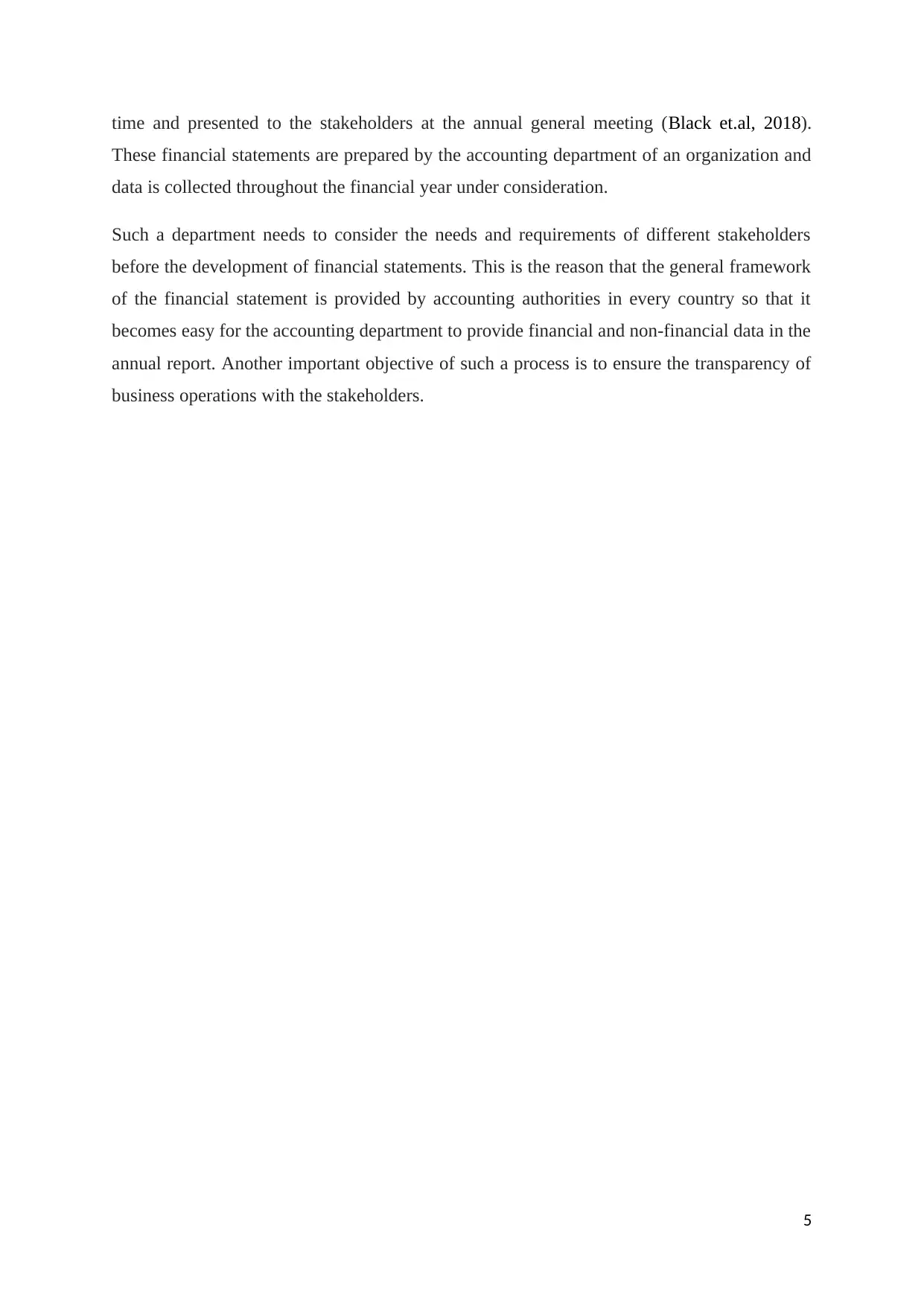
time and presented to the stakeholders at the annual general meeting (Black et.al, 2018).
These financial statements are prepared by the accounting department of an organization and
data is collected throughout the financial year under consideration.
Such a department needs to consider the needs and requirements of different stakeholders
before the development of financial statements. This is the reason that the general framework
of the financial statement is provided by accounting authorities in every country so that it
becomes easy for the accounting department to provide financial and non-financial data in the
annual report. Another important objective of such a process is to ensure the transparency of
business operations with the stakeholders.
5
These financial statements are prepared by the accounting department of an organization and
data is collected throughout the financial year under consideration.
Such a department needs to consider the needs and requirements of different stakeholders
before the development of financial statements. This is the reason that the general framework
of the financial statement is provided by accounting authorities in every country so that it
becomes easy for the accounting department to provide financial and non-financial data in the
annual report. Another important objective of such a process is to ensure the transparency of
business operations with the stakeholders.
5
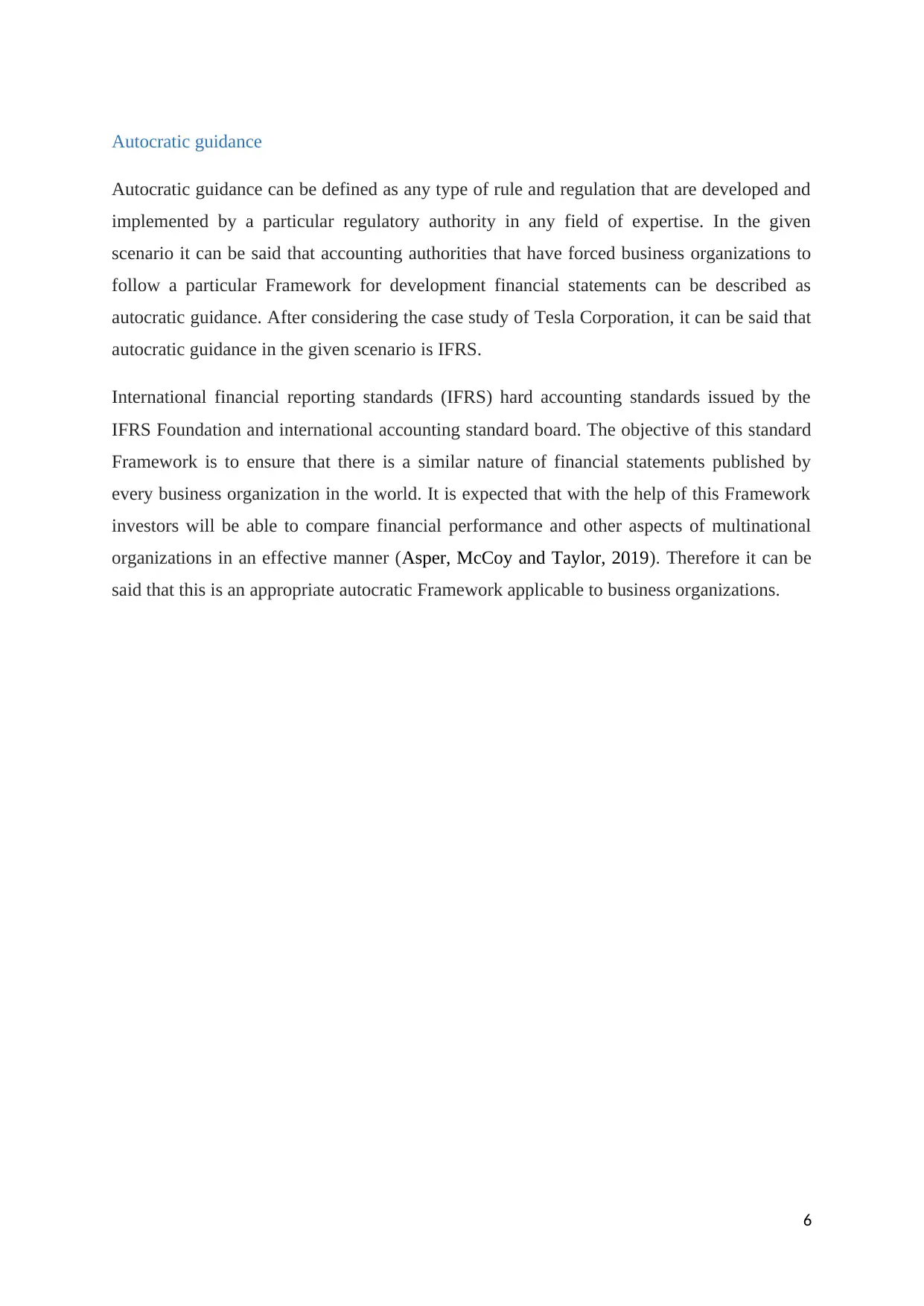
Autocratic guidance
Autocratic guidance can be defined as any type of rule and regulation that are developed and
implemented by a particular regulatory authority in any field of expertise. In the given
scenario it can be said that accounting authorities that have forced business organizations to
follow a particular Framework for development financial statements can be described as
autocratic guidance. After considering the case study of Tesla Corporation, it can be said that
autocratic guidance in the given scenario is IFRS.
International financial reporting standards (IFRS) hard accounting standards issued by the
IFRS Foundation and international accounting standard board. The objective of this standard
Framework is to ensure that there is a similar nature of financial statements published by
every business organization in the world. It is expected that with the help of this Framework
investors will be able to compare financial performance and other aspects of multinational
organizations in an effective manner (Asper, McCoy and Taylor, 2019). Therefore it can be
said that this is an appropriate autocratic Framework applicable to business organizations.
6
Autocratic guidance can be defined as any type of rule and regulation that are developed and
implemented by a particular regulatory authority in any field of expertise. In the given
scenario it can be said that accounting authorities that have forced business organizations to
follow a particular Framework for development financial statements can be described as
autocratic guidance. After considering the case study of Tesla Corporation, it can be said that
autocratic guidance in the given scenario is IFRS.
International financial reporting standards (IFRS) hard accounting standards issued by the
IFRS Foundation and international accounting standard board. The objective of this standard
Framework is to ensure that there is a similar nature of financial statements published by
every business organization in the world. It is expected that with the help of this Framework
investors will be able to compare financial performance and other aspects of multinational
organizations in an effective manner (Asper, McCoy and Taylor, 2019). Therefore it can be
said that this is an appropriate autocratic Framework applicable to business organizations.
6
⊘ This is a preview!⊘
Do you want full access?
Subscribe today to unlock all pages.

Trusted by 1+ million students worldwide
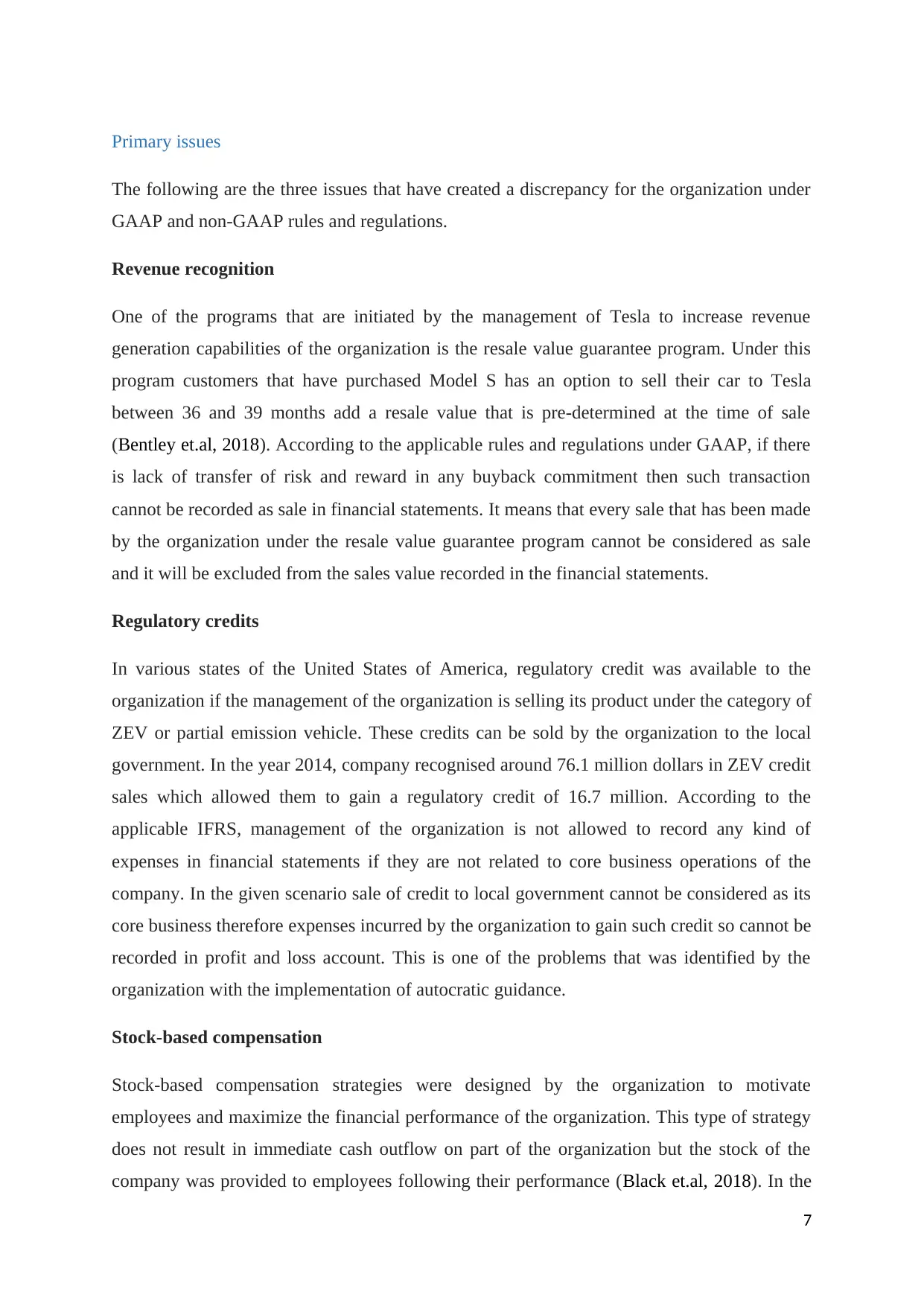
Primary issues
The following are the three issues that have created a discrepancy for the organization under
GAAP and non-GAAP rules and regulations.
Revenue recognition
One of the programs that are initiated by the management of Tesla to increase revenue
generation capabilities of the organization is the resale value guarantee program. Under this
program customers that have purchased Model S has an option to sell their car to Tesla
between 36 and 39 months add a resale value that is pre-determined at the time of sale
(Bentley et.al, 2018). According to the applicable rules and regulations under GAAP, if there
is lack of transfer of risk and reward in any buyback commitment then such transaction
cannot be recorded as sale in financial statements. It means that every sale that has been made
by the organization under the resale value guarantee program cannot be considered as sale
and it will be excluded from the sales value recorded in the financial statements.
Regulatory credits
In various states of the United States of America, regulatory credit was available to the
organization if the management of the organization is selling its product under the category of
ZEV or partial emission vehicle. These credits can be sold by the organization to the local
government. In the year 2014, company recognised around 76.1 million dollars in ZEV credit
sales which allowed them to gain a regulatory credit of 16.7 million. According to the
applicable IFRS, management of the organization is not allowed to record any kind of
expenses in financial statements if they are not related to core business operations of the
company. In the given scenario sale of credit to local government cannot be considered as its
core business therefore expenses incurred by the organization to gain such credit so cannot be
recorded in profit and loss account. This is one of the problems that was identified by the
organization with the implementation of autocratic guidance.
Stock-based compensation
Stock-based compensation strategies were designed by the organization to motivate
employees and maximize the financial performance of the organization. This type of strategy
does not result in immediate cash outflow on part of the organization but the stock of the
company was provided to employees following their performance (Black et.al, 2018). In the
7
The following are the three issues that have created a discrepancy for the organization under
GAAP and non-GAAP rules and regulations.
Revenue recognition
One of the programs that are initiated by the management of Tesla to increase revenue
generation capabilities of the organization is the resale value guarantee program. Under this
program customers that have purchased Model S has an option to sell their car to Tesla
between 36 and 39 months add a resale value that is pre-determined at the time of sale
(Bentley et.al, 2018). According to the applicable rules and regulations under GAAP, if there
is lack of transfer of risk and reward in any buyback commitment then such transaction
cannot be recorded as sale in financial statements. It means that every sale that has been made
by the organization under the resale value guarantee program cannot be considered as sale
and it will be excluded from the sales value recorded in the financial statements.
Regulatory credits
In various states of the United States of America, regulatory credit was available to the
organization if the management of the organization is selling its product under the category of
ZEV or partial emission vehicle. These credits can be sold by the organization to the local
government. In the year 2014, company recognised around 76.1 million dollars in ZEV credit
sales which allowed them to gain a regulatory credit of 16.7 million. According to the
applicable IFRS, management of the organization is not allowed to record any kind of
expenses in financial statements if they are not related to core business operations of the
company. In the given scenario sale of credit to local government cannot be considered as its
core business therefore expenses incurred by the organization to gain such credit so cannot be
recorded in profit and loss account. This is one of the problems that was identified by the
organization with the implementation of autocratic guidance.
Stock-based compensation
Stock-based compensation strategies were designed by the organization to motivate
employees and maximize the financial performance of the organization. This type of strategy
does not result in immediate cash outflow on part of the organization but the stock of the
company was provided to employees following their performance (Black et.al, 2018). In the
7
Paraphrase This Document
Need a fresh take? Get an instant paraphrase of this document with our AI Paraphraser

year ending 2014, it was identified by Anderson that total stock-based compensation of 39.2
million was added back by the organization in gap statement to arrive at the net income
following the non-gap statement.
8
million was added back by the organization in gap statement to arrive at the net income
following the non-gap statement.
8
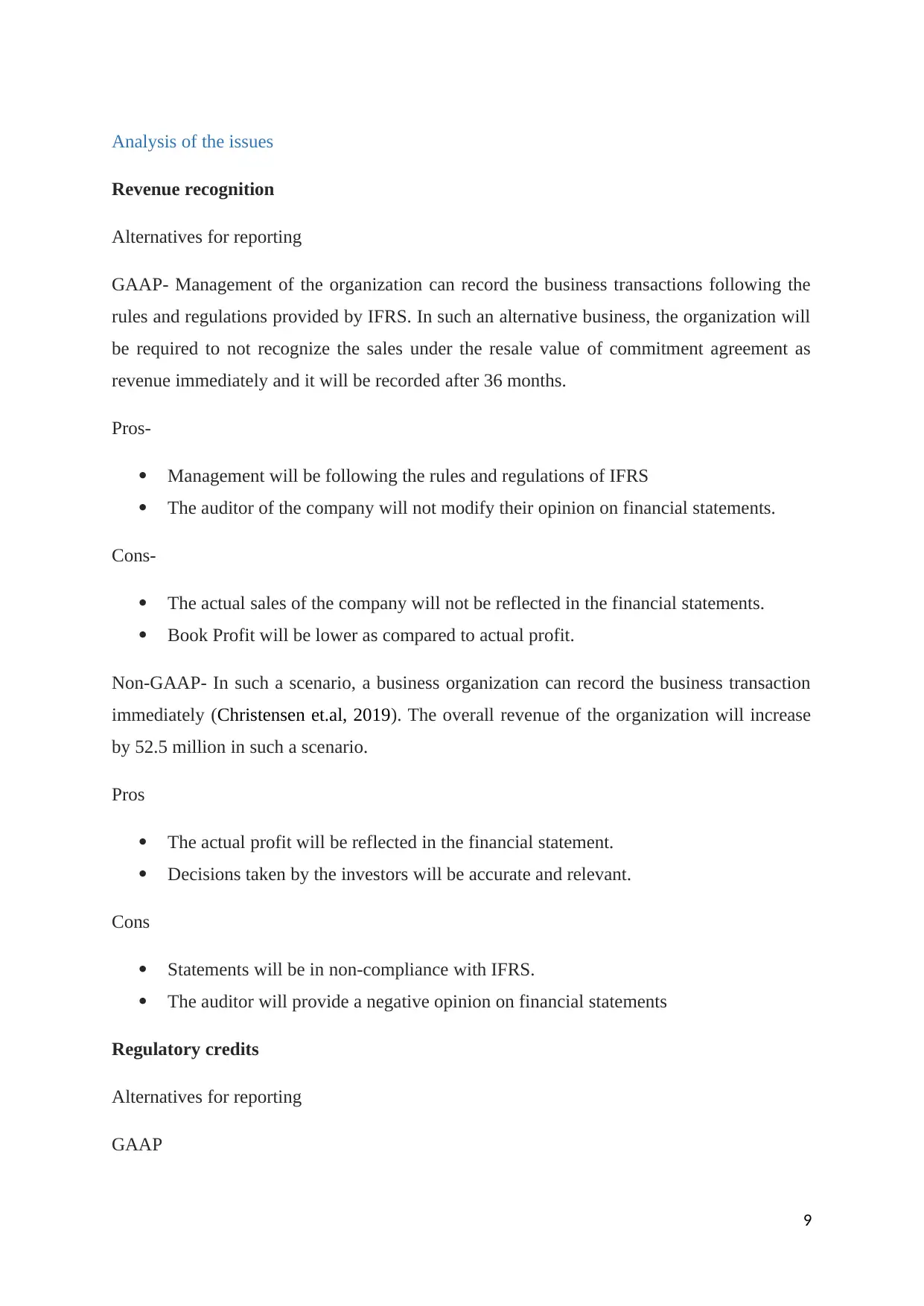
Analysis of the issues
Revenue recognition
Alternatives for reporting
GAAP- Management of the organization can record the business transactions following the
rules and regulations provided by IFRS. In such an alternative business, the organization will
be required to not recognize the sales under the resale value of commitment agreement as
revenue immediately and it will be recorded after 36 months.
Pros-
Management will be following the rules and regulations of IFRS
The auditor of the company will not modify their opinion on financial statements.
Cons-
The actual sales of the company will not be reflected in the financial statements.
Book Profit will be lower as compared to actual profit.
Non-GAAP- In such a scenario, a business organization can record the business transaction
immediately (Christensen et.al, 2019). The overall revenue of the organization will increase
by 52.5 million in such a scenario.
Pros
The actual profit will be reflected in the financial statement.
Decisions taken by the investors will be accurate and relevant.
Cons
Statements will be in non-compliance with IFRS.
The auditor will provide a negative opinion on financial statements
Regulatory credits
Alternatives for reporting
GAAP
9
Revenue recognition
Alternatives for reporting
GAAP- Management of the organization can record the business transactions following the
rules and regulations provided by IFRS. In such an alternative business, the organization will
be required to not recognize the sales under the resale value of commitment agreement as
revenue immediately and it will be recorded after 36 months.
Pros-
Management will be following the rules and regulations of IFRS
The auditor of the company will not modify their opinion on financial statements.
Cons-
The actual sales of the company will not be reflected in the financial statements.
Book Profit will be lower as compared to actual profit.
Non-GAAP- In such a scenario, a business organization can record the business transaction
immediately (Christensen et.al, 2019). The overall revenue of the organization will increase
by 52.5 million in such a scenario.
Pros
The actual profit will be reflected in the financial statement.
Decisions taken by the investors will be accurate and relevant.
Cons
Statements will be in non-compliance with IFRS.
The auditor will provide a negative opinion on financial statements
Regulatory credits
Alternatives for reporting
GAAP
9
⊘ This is a preview!⊘
Do you want full access?
Subscribe today to unlock all pages.

Trusted by 1+ million students worldwide
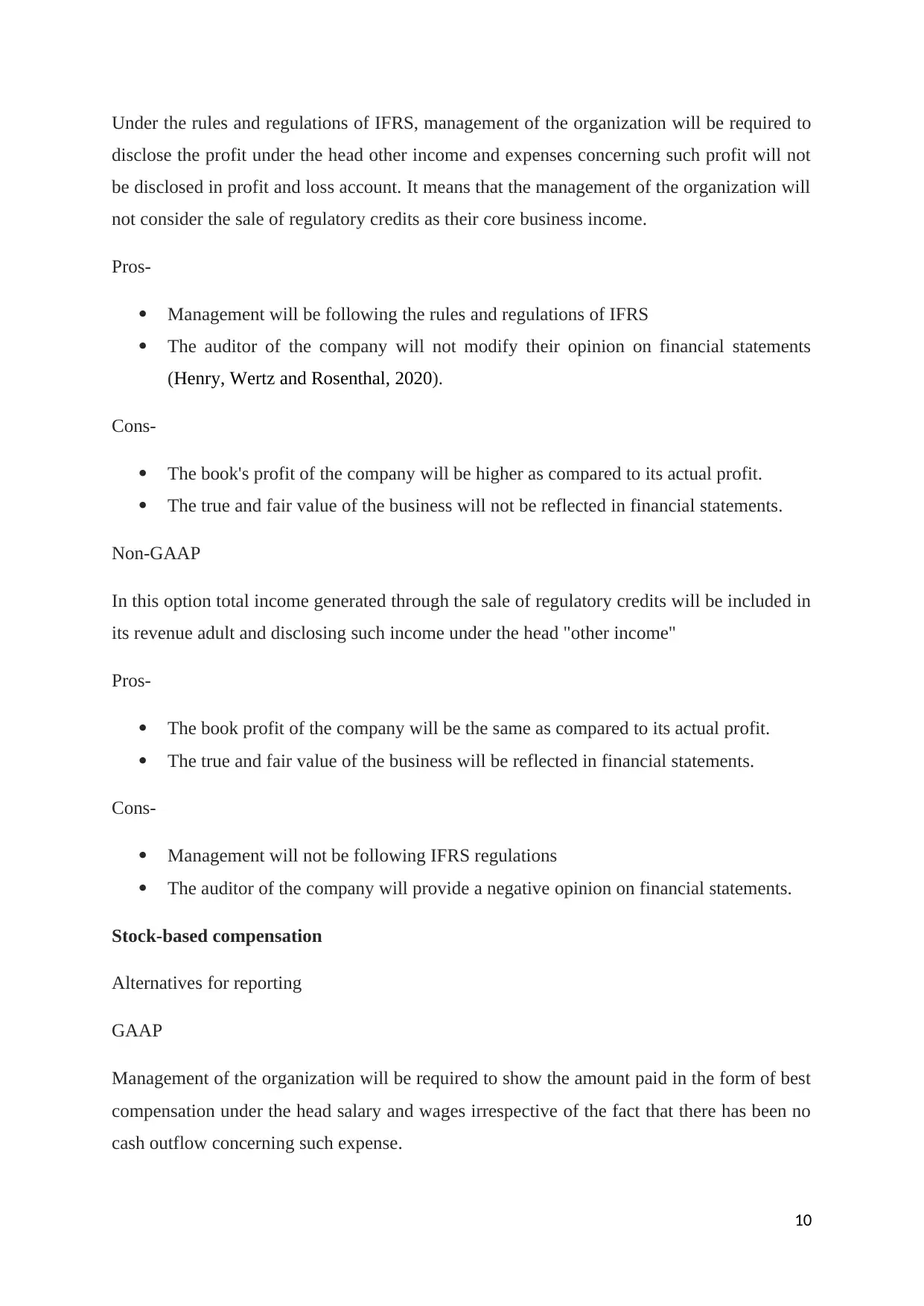
Under the rules and regulations of IFRS, management of the organization will be required to
disclose the profit under the head other income and expenses concerning such profit will not
be disclosed in profit and loss account. It means that the management of the organization will
not consider the sale of regulatory credits as their core business income.
Pros-
Management will be following the rules and regulations of IFRS
The auditor of the company will not modify their opinion on financial statements
(Henry, Wertz and Rosenthal, 2020).
Cons-
The book's profit of the company will be higher as compared to its actual profit.
The true and fair value of the business will not be reflected in financial statements.
Non-GAAP
In this option total income generated through the sale of regulatory credits will be included in
its revenue adult and disclosing such income under the head "other income"
Pros-
The book profit of the company will be the same as compared to its actual profit.
The true and fair value of the business will be reflected in financial statements.
Cons-
Management will not be following IFRS regulations
The auditor of the company will provide a negative opinion on financial statements.
Stock-based compensation
Alternatives for reporting
GAAP
Management of the organization will be required to show the amount paid in the form of best
compensation under the head salary and wages irrespective of the fact that there has been no
cash outflow concerning such expense.
10
disclose the profit under the head other income and expenses concerning such profit will not
be disclosed in profit and loss account. It means that the management of the organization will
not consider the sale of regulatory credits as their core business income.
Pros-
Management will be following the rules and regulations of IFRS
The auditor of the company will not modify their opinion on financial statements
(Henry, Wertz and Rosenthal, 2020).
Cons-
The book's profit of the company will be higher as compared to its actual profit.
The true and fair value of the business will not be reflected in financial statements.
Non-GAAP
In this option total income generated through the sale of regulatory credits will be included in
its revenue adult and disclosing such income under the head "other income"
Pros-
The book profit of the company will be the same as compared to its actual profit.
The true and fair value of the business will be reflected in financial statements.
Cons-
Management will not be following IFRS regulations
The auditor of the company will provide a negative opinion on financial statements.
Stock-based compensation
Alternatives for reporting
GAAP
Management of the organization will be required to show the amount paid in the form of best
compensation under the head salary and wages irrespective of the fact that there has been no
cash outflow concerning such expense.
10
Paraphrase This Document
Need a fresh take? Get an instant paraphrase of this document with our AI Paraphraser
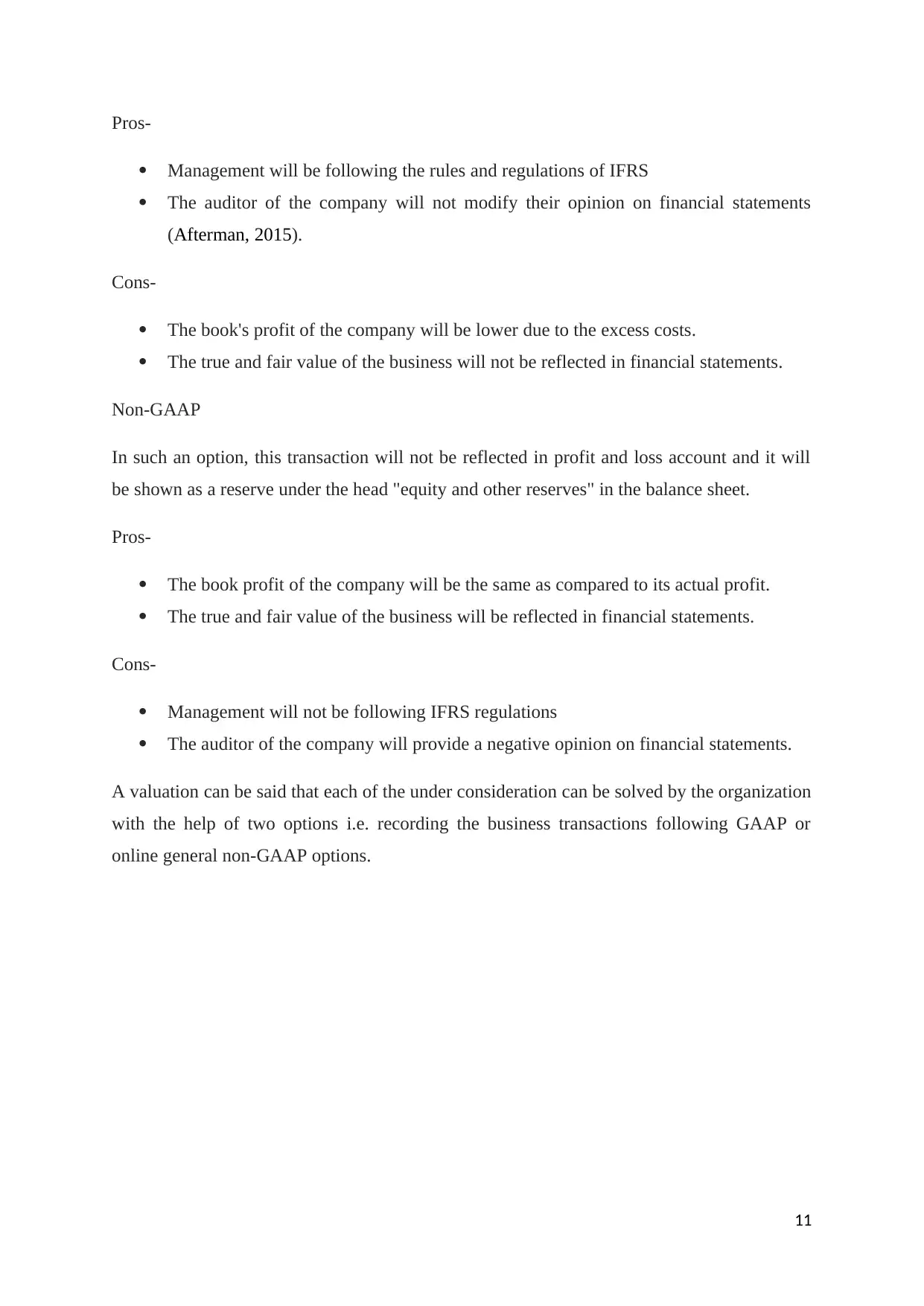
Pros-
Management will be following the rules and regulations of IFRS
The auditor of the company will not modify their opinion on financial statements
(Afterman, 2015).
Cons-
The book's profit of the company will be lower due to the excess costs.
The true and fair value of the business will not be reflected in financial statements.
Non-GAAP
In such an option, this transaction will not be reflected in profit and loss account and it will
be shown as a reserve under the head "equity and other reserves" in the balance sheet.
Pros-
The book profit of the company will be the same as compared to its actual profit.
The true and fair value of the business will be reflected in financial statements.
Cons-
Management will not be following IFRS regulations
The auditor of the company will provide a negative opinion on financial statements.
A valuation can be said that each of the under consideration can be solved by the organization
with the help of two options i.e. recording the business transactions following GAAP or
online general non-GAAP options.
11
Management will be following the rules and regulations of IFRS
The auditor of the company will not modify their opinion on financial statements
(Afterman, 2015).
Cons-
The book's profit of the company will be lower due to the excess costs.
The true and fair value of the business will not be reflected in financial statements.
Non-GAAP
In such an option, this transaction will not be reflected in profit and loss account and it will
be shown as a reserve under the head "equity and other reserves" in the balance sheet.
Pros-
The book profit of the company will be the same as compared to its actual profit.
The true and fair value of the business will be reflected in financial statements.
Cons-
Management will not be following IFRS regulations
The auditor of the company will provide a negative opinion on financial statements.
A valuation can be said that each of the under consideration can be solved by the organization
with the help of two options i.e. recording the business transactions following GAAP or
online general non-GAAP options.
11
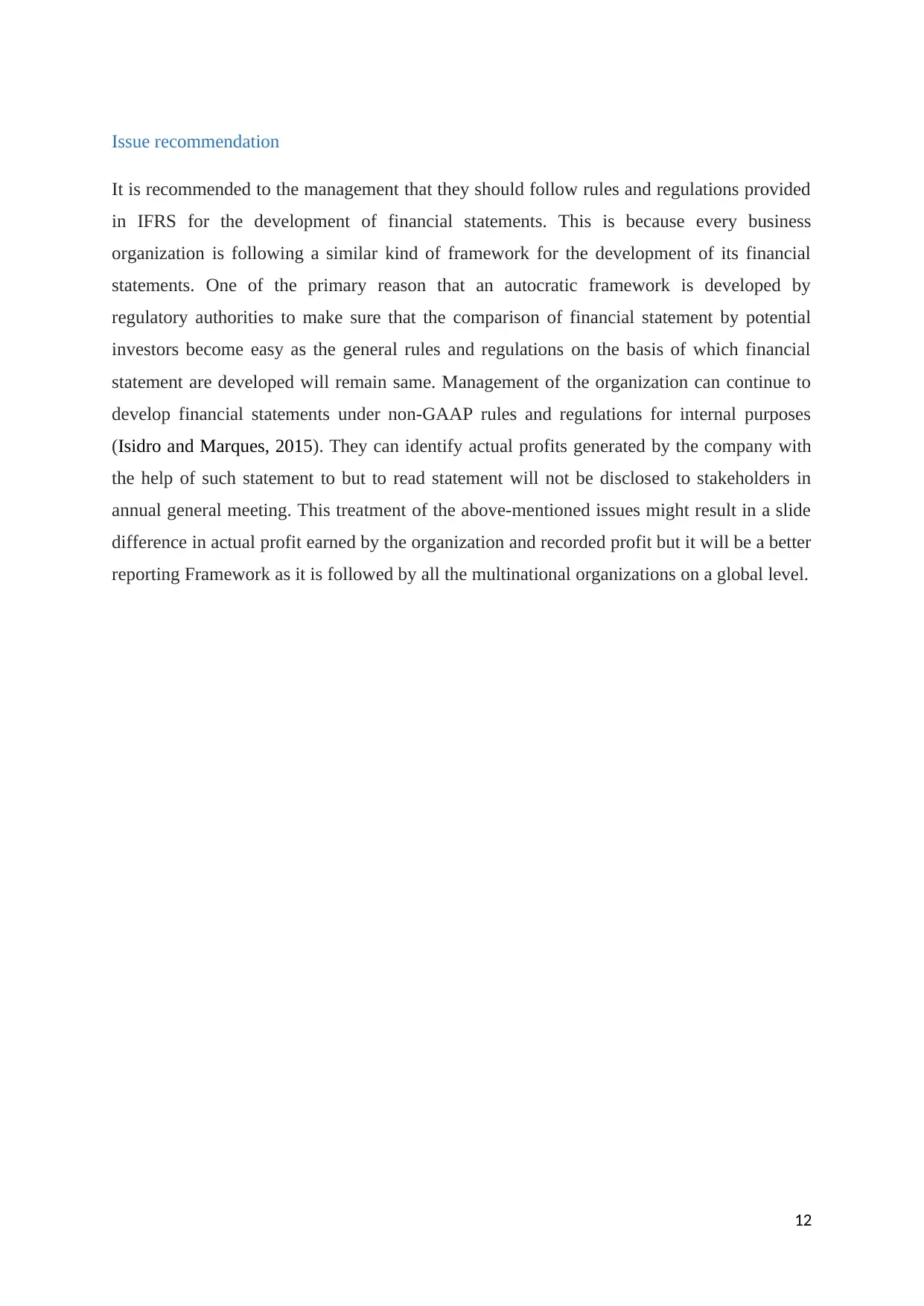
Issue recommendation
It is recommended to the management that they should follow rules and regulations provided
in IFRS for the development of financial statements. This is because every business
organization is following a similar kind of framework for the development of its financial
statements. One of the primary reason that an autocratic framework is developed by
regulatory authorities to make sure that the comparison of financial statement by potential
investors become easy as the general rules and regulations on the basis of which financial
statement are developed will remain same. Management of the organization can continue to
develop financial statements under non-GAAP rules and regulations for internal purposes
(Isidro and Marques, 2015). They can identify actual profits generated by the company with
the help of such statement to but to read statement will not be disclosed to stakeholders in
annual general meeting. This treatment of the above-mentioned issues might result in a slide
difference in actual profit earned by the organization and recorded profit but it will be a better
reporting Framework as it is followed by all the multinational organizations on a global level.
12
It is recommended to the management that they should follow rules and regulations provided
in IFRS for the development of financial statements. This is because every business
organization is following a similar kind of framework for the development of its financial
statements. One of the primary reason that an autocratic framework is developed by
regulatory authorities to make sure that the comparison of financial statement by potential
investors become easy as the general rules and regulations on the basis of which financial
statement are developed will remain same. Management of the organization can continue to
develop financial statements under non-GAAP rules and regulations for internal purposes
(Isidro and Marques, 2015). They can identify actual profits generated by the company with
the help of such statement to but to read statement will not be disclosed to stakeholders in
annual general meeting. This treatment of the above-mentioned issues might result in a slide
difference in actual profit earned by the organization and recorded profit but it will be a better
reporting Framework as it is followed by all the multinational organizations on a global level.
12
⊘ This is a preview!⊘
Do you want full access?
Subscribe today to unlock all pages.

Trusted by 1+ million students worldwide
1 out of 15
Related Documents
Your All-in-One AI-Powered Toolkit for Academic Success.
+13062052269
info@desklib.com
Available 24*7 on WhatsApp / Email
![[object Object]](/_next/static/media/star-bottom.7253800d.svg)
Unlock your academic potential
Copyright © 2020–2025 A2Z Services. All Rights Reserved. Developed and managed by ZUCOL.



